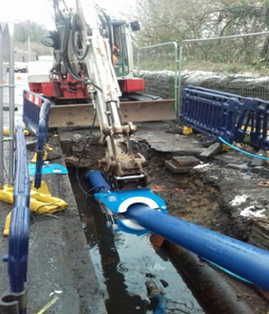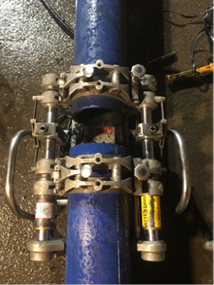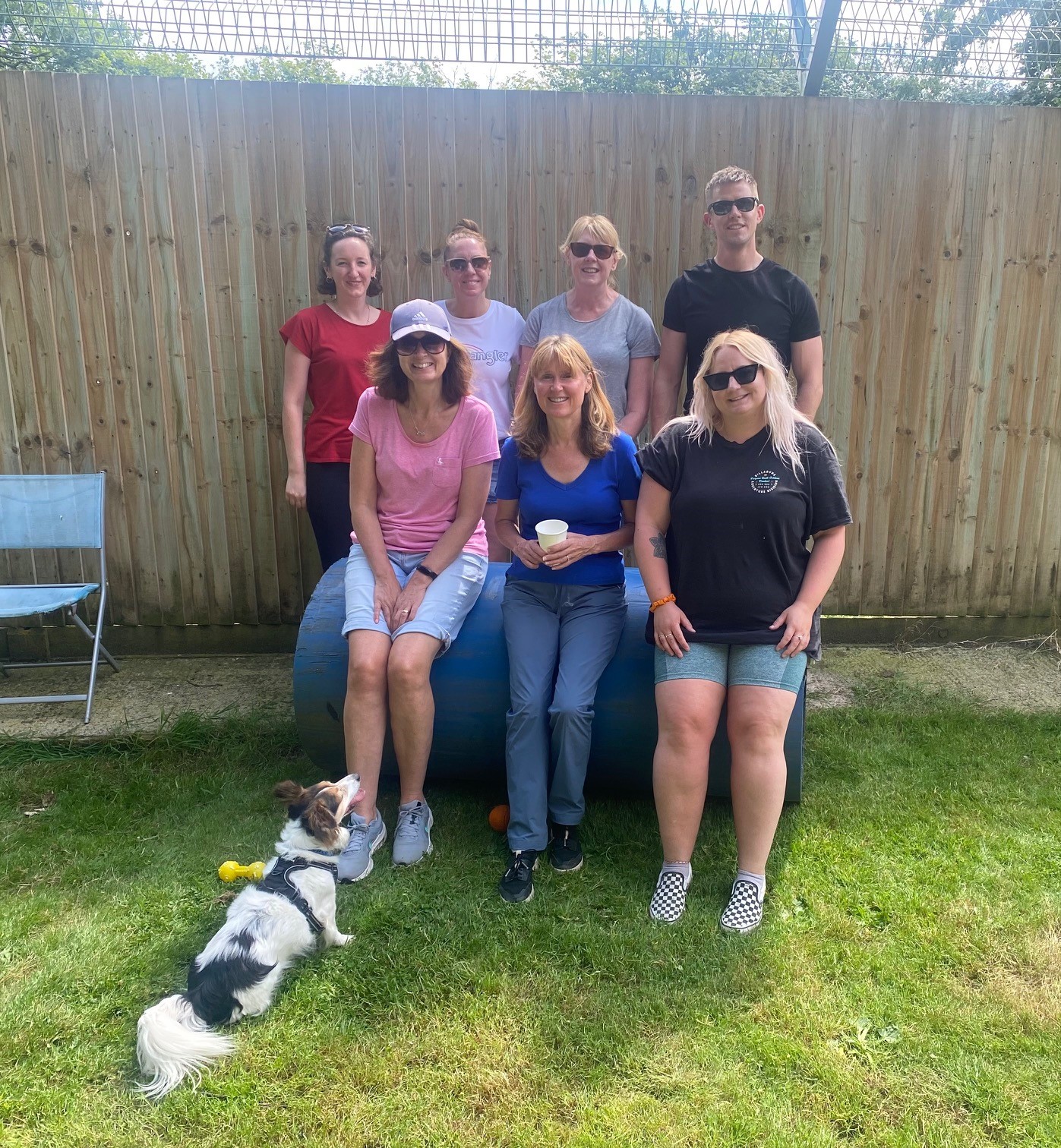
Location: Maerdy, South Wales
Project Type: Mains Rehab
Client: Dwr Cymru Welsh Water
Project Duration: 6 months
Contract Value: £900k

Maredy & Pontypridd are towns located in the Rhondda Fach Valley in South Wales. A network of cast iron water mains were constructed in the early 20th Century to serve the mining communities but due to the rapid deindustrialisation throughout the South Wales Valley the network has become oversized and prone to corrosion and deposition.
As part of the AMP 6 programme DCWW has recognised the need to replace the existing asset due to high leakage and poor performance for many years. The Route of the pipeline runs through a plethora of urban and extra urban communities and traffic sensitive areas with the urban setting making the network difficult to maintain. The scheme was broken down into two sections; 2250m of slip lining and 650m of open cut. By using the skills of its long term supply chain members, Envolve were able to minimise disruption throughout what was an already compromised network by designing an “online trenchless” solution. Installing approximately 2.3km of 180mm HPPE water main throughout the community, never once making interruption to their supply. From the outset DCWW stressed the importance of reducing the risk of disruption to their network. It was fundamental that no customer should be directly or indirectly affected as a result of the operation.

For over 30 years Envolve has continually evolved to meet the construction challenges set by our clients and to deliver a complete construction package. We bring a solid track record of success in delivering high complexity works. We deliver on time, within budget and to the highest standard of quality. Envolve provided a local, experienced team at the design stage to work in tandem with the DCWW Capital Team to deliver the project. With our high regard for collaborative working, we project managed the scheme involving strategic partners, key subcontractors, local businesses,
DCWW operations, local highways agencies and more so the local residence and customers throughout the project. Working closely in liaison with the local highways authority (RCT), our appointed TMA subcontractors (Amberon) and the DCWW Streetworks, road notice applications were submitted for road closures and temporary traffic lights. These were fully maintained and supported 24/7, therefore safeguarding our client’s reputation. Should an emergency have occurred outside of working hours a dedicated response team was established to support our client wherever necessary. All plant / equipment and contingency fittings were readily available on site prior to embarking on the project.

Through our robust safe systems of work and good levels of communication, Envolve managed the construction project to the highest standards of H&S. There were a number of risks highlighted during the design stage: Working at height when entering and leaving cofferdam excavations, working on large diameter high pressure water mains, working in close proximity of medium pressure gas mains and working in the highway. These risks were highlighted in the RAMS and control measures put in place prior to commencement of works. Due to the nature of working on DCWW strategic water mains all working methods are in line with DCWW’s HSP124. RAMS and the CPP were developed and continually updated as the work evolves. Also:
To ensure quality control all pipes and fittings were stored off the ground and all pipes of all sizes were cap ended.
Due to the nature of working on potable water mains Hygiene is of the utmost importance and the risk of cross contamination must be avoided at all times. All personnel working on the scheme held a minimum of a valid EUSR Water Hygiene Card. All fuels were stored in bunded bowsers.

Due to the complexity of the construction project Envolve formed a local, highly experienced management team who had the knowledge to deliver the scheme from design stage through to completion. The combined skill set of the team proved invaluable in delivering this highly complex project. This management structure has proven invaluable, continually updating our client on key indicators such as safety, quality, programme and budget. Within this team we had the necessary skills to allow effective planning of the work to maintain a key milestone, ultimately reducing the impact to our client’s customers. Monthly meetings were set up between all parties. Information such as programmes, safety and commercial including EWN would be discussed with DCWW. As a direct result of our diligence, Envolve delivered the project in line with key parameters. Safely, High Quality, On time & on budget.

During the ECI stage of works Envovle identified that one of the existing water mains (9” & 10”) had the opportunity to be slip lined, thus reducing the cost of traditional open cut techniques. The existing assets were located on a traffic sensitive road (A4058) and the Local Highway Authority stipulated that any works within the carriageway had to be carried at night. Instead of the several shifts which would have been required for the proposed method of Open Cut, all working areas were sealed up and TM off the road by the following morning.
Protection Measures—Risk Mitigation
One of the main benefits of early contractor involvement was that the construction team were fully aware of our client identified Risk from the outset. With this transparency, engineering solutions were implemented during ECI, therefore mitigating client risk before site mobilisation. Envolve also mitigated the DCWW operational risk of planned shut downs and reduced customer impact by installing under pressure tee and line stops. This enabled us to complete the scheme whilst keeping the existing network live, continuingly supplying thousands of customers in South Wales

The scheme was managed by an experienced team, all of whom have worked on multiple Welsh Water projects. Our Project Manager and Construction Manager have both worked for Envolve in excess of 20 years and have a wealth of experience in sliplining and pipe bursting. Delivery of the scheme was via our own workforce enabling us to offer a saving over the alternative of subcontracting, passing on value to Welsh Water.

Working along aside DCWW Welsh Water for over 30yrs, it isn’t coincidental that our company ethos complements one another almost seamlessly. We are proud to have received letters of acknowledgement from the public for this particular scheme. Through early contractor involvement we were able to host multiple public information events in and around the communities of the Rhondda Valley. These communities were really pleased that we as the principal contractor and our client took the time to inform them of fine detail prior to its commencement. Our TM subcontractor was also involved to answer queries regarding Traffic Management and the potential for access restrictions. This was very useful for all parties to understand access requirements and restrictions during the construction phase. Many customers were extremely complementary of the positive interaction during the event and were happy to continue liaison throughout the scheme. These contacts went on to prove invaluable during the construction phase, keeping Envolve continually updated. Envolve in turn administer weekly progress updates which proved extremely useful in keeping local residents and local transport companies informed.

The contract was completed in June 2019 with 650m of open cut and 2250m of slip lining 180mm potable water main together with the cutting and capping of the existing 9” & 10” water mains. Compensation events were agreed during the progress of the works and in regular commercial meetings meaning the final account was agreed at completion. Prior to handing the scheme back to DCWW Operations there were no defects reported during testing & commissioning. Following completion of road sections a reinstatement spread sheet was forwarded onto DCWW Streetworks, minor defects were quickly closed out by the Envolve Manager and the DCWW Streetworks Manager with highway defects signed off with local inspector. A handover file was produced and handed over to DCWW Capital Team within 2 weeks.

This task statement has been written to detail the activities involved with the excavation of multiple Launch/Reception pits and the installation of new HPPE pipe by Slip lining methods and techniques within existing 9” Cast Iron water main that will be isolated to undertake the mains renewal along section of works between Trehafod and Pontypridd. All works will be undertaken under DCWW permit to work system and a certificate of isolation will be issued on commencement of the slip lining activity once the abandoned main is adopted for the 1st time, the C.O.I. will remain open until the new main has been installed and cut & caps have been completed.
The required Launch/Reception Excavations will be carried out at pre-determined locations where the pits can also be used for connections to supply adjacent distribution mains along the intended route if applicable. The launch/reception pits will be of varying distances from each other to allow installation in the most efficient manner. The position of each excavation will be confirmed by the Site Manger and relayed to the team to ensure installation is carried out efficiently and all other subsidiary works can be planned and programmed accordingly.
The excavation areas selected will also take into account the presence of any utility services highlighted on the utility plans provided. The excavations will locate and expose the existing 9” Cast Iron water main to allow insertion of smaller new mains to be undertaken. Additional care will be taken during the excavation process due to the presence of a 10” trunk water main also traversing the route along the A4058. This has been visibly identified several times previously with the proximity of the mains to each other being as little as 200mm separation. The existing water mains will be sliplined with new HPPE coiled pipe for diameters up to and including 180mm, or pre-butt fused pipe strings for all new HPPE water pipe above 180mmØ.
For each excavation, area utility plans will be closely studied, identifying any buried apparatus. The immediate vicinity will be visually surveyed to identify possible services routes and drainage systems that run through the proposed work area. The excavation area then now be scanned using the eCAT4+ & Genny with all findings marked on the ground along the perceived tracked route with spray paint for future reference. The CAT is very limited without the use of the Genny in tracing potential buried services—so make sure you use it!
A permit to work (PTW) will be issued by DCWW as per requirement listed within HSP124 – procedure document relating to works in close proximity to live strategic assets. Once the area has been scanned, and deemed safe to excavate (ie no services have been highlighted, and there are no obvious signs of trench lines, old excavations, marker signs, manhole or duct boxes etc.) then an excavator fitted with a TOOTHLESS bucket can remove the surface of the soil. If the excavations are within the highway, the tarmac surface will be cut using a road saw (complete with a water supply to supress any dust created). The operator will wear eye, respiratory and hearing protection whilst using the saw. Vibration exposure must be recorder and monitored when using any item of equipment that can expose the user to hand arm vibration risks.
All excavation work will be under the supervision of a competent banksman. NOTE:- Excavations are expected to be depths between 1.2m and 1.6m therefore shoring equipment at some locations may be necessary. Each excavation will be assessed individually by the site manager or site supervisor as to what.

The existing main will be drilled and tapped and a ferrule installed to allow controlled access and discharge any redundant water pressure within the isolated section of main. This may also be utilised to drain down the section of main if no other fire hydrants are within the isolation section. Once satisfied that the water main contains no redundant water pressure, a section of the pipe can be removed on both the launch and reception pits following a satisfactory lift assessment have been carried out. The existing water main will be cut using a disc cutter.
A camera survey will be undertaken of the internal of the existing main for the full length of intended slip lining section to confirm suitability and identify potential obstructions that could be removed to allow a successful installation. Where the work site is of sufficient length that both launch and reception pits can be excavated within same TM arrangement, it is vital that a radio link between launch and reception pits is maintained throughout the operation to ensure safe working practices are adhered to at both ends of the works. The slip lining operation will continue until the new pipe is exposed within the reception pit. The new pipe can then connected to the new connection complexes or pieced into the last section of new main. Should the newly installed section of main need to be installed directly into a live network, temporary test ends will be installed at either end and the commissioning process will commence including the chlorination and sampling to confirm new main is satisfactory clean to allow the connection into the live network. Whilst working on the pipe and fittings all operatives must practice high levels of hygiene ensuring all pipes are clean and plenty of Chlorus solution (1000mg/l) is sprayed to kill any bacteria that may be present. All operatives working on the pipes must hold the EUSR Water Hygiene Card.
An 8t mechanical excavator fitted with a hydraulic Poly Pipe Pusher attachment will be positioned at the end of the launch pit above the main to be inserted. When the excavator and coil trailer are in position, the perimeter of the slip lining zone will be fenced off to prevent accidental access during the works. Once the operator and banksman are satisfied that the immediate work zone is secure, the slip lining operation can commence. The excavator will grasp the new HPPE pipe and pull towards the open end of the existing/abandoned main ensuring the tapered lead pipe enters the old main, the pusher attachment will then be released and re-gripped further back to be pulled in again. This action will be repeated until the desired length is installed, care will taken by the operator not to gouge the new HPPE pipe against the existing abandoned main which could result in a pipe failure (burst) once main is pressurised. A banksman will supervise the operation to ensuring adequate clearance is kept away from the adjacent live water main.
Where the required installation length is greater than a coil of pipe, additional 6mtr pipe lengths and/or pipe coils will be butt fused to extend the pipe string to the desired installation length. Once new HPPE pipe has been installed to the desired length, any surplus pipe will be cut off and pipe end capped off to prevent accidental contamination until jointing is carried out. Should the pipe string stop due to unidentified obstruction, location will be excavated and section of existing/ abandoned main will be cut out to allow slip lining operation to continue. Should area of unidentified obstruction occur outside of works area / traffic management area, slip lining will cease and next slip lining launch pit distance will be re-calculated to allow next pipe string to be installed back to last pipe install location.

Holdenhurst WRC
A £30 million investment by Wessex Water to protect Bournemouth's popular beaches
Location: Bournemouth
Project Type: Water Treatment
Client: Wessex Water
Project Duration: 24 months
Contract Value: £14.5m

Holly Hedge Animal Sanctuary
Its amazing to see how our time can benefit the sanctuary and its residents.
Location: Holly Hedge Animal Sanctuary
Project Type: ESG
Client: Community Volunteering
Project Duration: 1 day!
Contract Value: £0







